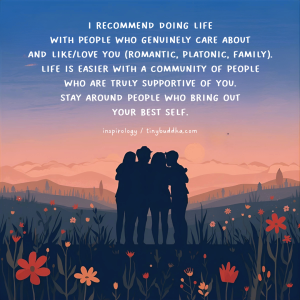Update: The winners for this giveaway have been chosen. Subscribe to Tiny Buddha to learn about future giveaways!
The winners:
As you can likely tell from the number of author interviews/giveaways I’ve posted during these last few weeks, I’ve been receiving and reading a wide selection of books lately. One-Minute Mindfulness is now sitting on my coffee table, where I know I will refer it often.
The full title reads One-Minute Mindfulness: 50 Simple Ways to Find Peace, Clarity, and New Possibilities in a Stressed-Out World. It delivers on its promise.
From the Amazon Description:
In this book, Donald Altman brings the benefits of mindfulness down to earth and into everyday life. With fifty exercises and practices to build awareness and center attention, you will discover how to savor routine pleasures, build fulfillment in your work, enhance and heal relationships, change unhealthy habits, and connect to peace even in the midst of chaos or uncertainty.
The Giveaway
To enter to win one of 5 free copies of One-Minute Mindfulness:
- Leave a comment on this post.
- Tweet: RT @tinybuddha Giveaway and Interview: One-Minute Mindfulness by Donald Altman http://bit.ly/mQfaHA
You can enter until midnight PST on Sunday, September 25th.
The Interview
1. In your book, One Minute Mindfulness, you offer a variety of practices to create mindfulness in 60 seconds. It’s an accessible practice, since everyone can find a minute here and there throughout their day. Do you find that integrating these practices into a daily routine creates more mindfulness overall?
In my mind, there’s no question that this increases the level of overall mindfulness. This is actually in line with the Buddha’s teachings—that mindfulness is used every possible moment. And it’s why mindfulness is considered to be a path to enlightenment.
Each next sixty seconds holds the potential for anyone to open with spaciousness to whatever is happening, to see the truth of that moment. You can only do that in the next minute that is right before you, which is why a one-minute mindfulness practice is so valuable.
2. What do you think are the biggest obstacles to mindfulness—and why is it so important?
One of the biggest obstacles to being mindful is the extreme amount of distractions that we face daily—and which produces restlessness, anxiety, and busyness in the mind. Take an inventory and notice how many things are trying to capture your attention—which is one the most valuable treasures that you possess.
Watching and observing the mind is also a one-minute mindfulness practice that I’ve included in the book for this reason, as well as ways to slow and calm the mind, allowing it to rest in quiet expansiveness.
3. In your work as a psychotherapist, have you found one-minute mindfulness to be an effective strategy for letting go of pain from the past?
I use a one-minute mindfulness approach with many of the people who come to see me for depression, anxiety, loss, and grief. The method is effective because it lets you master your awareness and attention by turning away from focusing on a source of suffering and turning you toward a source of joy and gratitude.
Happiness is not out there, but is a one-minute mindfulness practice of deciding where you want to focus the power of attention. For example, you can focus on what’s missing in your life and feel miserable, or you can turn your gaze toward appreciating what’s present and find new possibilities and hope. You can’t do that by purchasing a new toaster.
4. Can anyone reap the same benefits from one-minute mindfulness, regardless of their level of busyness?
That’s a good question, because the truth is that the more you practice, the easier it is to shift into the mindful minute. At the same time, I think anyone will find benefit, but the perceived benefit will be experienced according to the degree of difficulty.
Let me explain by using the metaphor of gymnastics. A beginning gymnast can learn a simple tumbling move and perfect it, which will leave them feeling great. A more experienced gymnast will try a higher degree tumbling move because they are more skilled. Both are applying their gymnastic training and getting equal amounts of satisfaction from it.
The same is true of one-minute mindfulness practices whether you are a beginner, intermediate, or advanced practitioner. The mindfulness beginner might begin to notice and change more extreme and obvious habits of mind or actions—such as angry outbursts.
The more advanced practitioner might observe more subtle and nuanced mind habits, such as mental intentions and mental rigidity. While both are applying the skills, it is the degree of practice that changes how mindfulness is felt, or experienced.
5. Is one-minute mindfulness an alternative to traditional meditation?
I think both one-minute mindfulness and traditional meditation are important and of value. One-minute mindfulness is critical because it can be more accessible to those who can’t find the time for sitting for 20, 30, or 60 minutes of traditional meditation.
Once people start to experience one-minute mindfulness, they will get to a place where they will want to deepen the sense of peace they are getting by sitting in traditional meditation. Vice-versa, if someone is already doing a traditional sitting meditation, they will want to find a way to integrate the peace of that into their daily life.
So one-minute mindfulness and traditional meditation actually work together seamlessly. They are two sides of the same coin, and you can’t have a coin with just one side.
6. In your book, you devote an entire section to one-minute mindfulness in relationships, including suggestions such as “listen without judgment” and “let it be.” Are these practices most effective when both individuals in the relationship practice them?
I included a section on “One-minute Mindfulness for Relationships and Love” in the book because mindfulness is not just an individual pursuit. Sometimes we think that mindfulness is for the individual, but there is shared mindfulness all around us because at its core, mindfulness is about relationship—what’s the relationship we’re having with anything in our lives?
It is an I-It relationship, where we view things as external objects to be manipulated? Or, can we enter the dynamic, compassionate I-Thou relationship with all that we find around us? Since no-one can control another, we need to take responsibility for being mindful in relationships, regardless of whether the other is being mindful.
If you are mindful in a relationship, you are being effective and skillful with your kindness and hospitality and acceptance. That often changes the dynamics of the relationship, but such mindfulness is done not to manipulate another but because mindfulness is trying to reduce harm and suffering.
Mindfulness in relationships is very potent, and there have even been some studies that couples that practice these tools strengthen their relationships. It’s challenging too, because it asks the mindfulness practitioner to let go of preconceived ideas about whoever they are relating to.
7. Of the 50 mindfulness exercises in your book, which has been the most powerful for you personally, and why?
Let me use breathing as a metaphor for mindfulness. Personally, mindfulness is like breathing. Without it, living would be labored and probably like a constant asthma attack. How I use mindful awareness depends on what’s happening in my life.
Lately, I’ve been getting a lot out of the last section of the book, “One-Minute Mindfulness for Nature, Spirituality, and Contemplation.” I have been connecting with silence, listening to lessons from the earth, and focusing on messages of peace—all chapters in the last section.
I don’t really know how I could have found a sense of calm, insight, and gotten clarity without these at my side. I’m always finding a view of nature’s beauty. This morning, for example, I spent time looking at broad maple trees, leafy elms, and in the distance, towering Douglas fir trees that reach into the blue horizon.
Trees are nature’s largest organisms, and there are trees that are almost 5,000 years old sharing this planet. We can learn a lot from these peaceful neighbors. I am grateful for what mindfulness can offer each of us.
8. What’s the most important message you hope readers take away from One-Minute Mindfulness?
Don’t give up on mindfulness. Don’t give up on realizing the in-lightened view that it can give you and nourish you with. One-minute mindfulness is all you need right now. May it open the door to joy and let you find all the blessings that are hidden in plain view in the next sixty seconds!
You can learn about One Minute-Mindfulness on Amazon here.
FTC Disclosure: I receive complimentary books for reviews and interviews on tinybuddha.com, but I am not compensated for writing or obligated to write anything specific. I am an Amazon affiliate, meaning I earn a percentage of all books purchased through the links I provide on this site.
About Lori Deschene
Lori Deschene is the founder of Tiny Buddha. She started the site after struggling with depression, bulimia, c-PTSD, and toxic shame so she could recycle her former pain into something useful and inspire others to do the same. You can find her books, including Tiny Buddha’s Gratitude Journal and Tiny Buddha’s Worry Journal, here and learn more about her eCourse, Recreate Your Life Story, if you’re ready to transform your life and become the person you want to be.
- Web |
- More Posts














 Though I run this site, it is not mine. It's ours. It's not about me. It's about us. Your stories and your wisdom are just as meaningful as mine.
Though I run this site, it is not mine. It's ours. It's not about me. It's about us. Your stories and your wisdom are just as meaningful as mine.